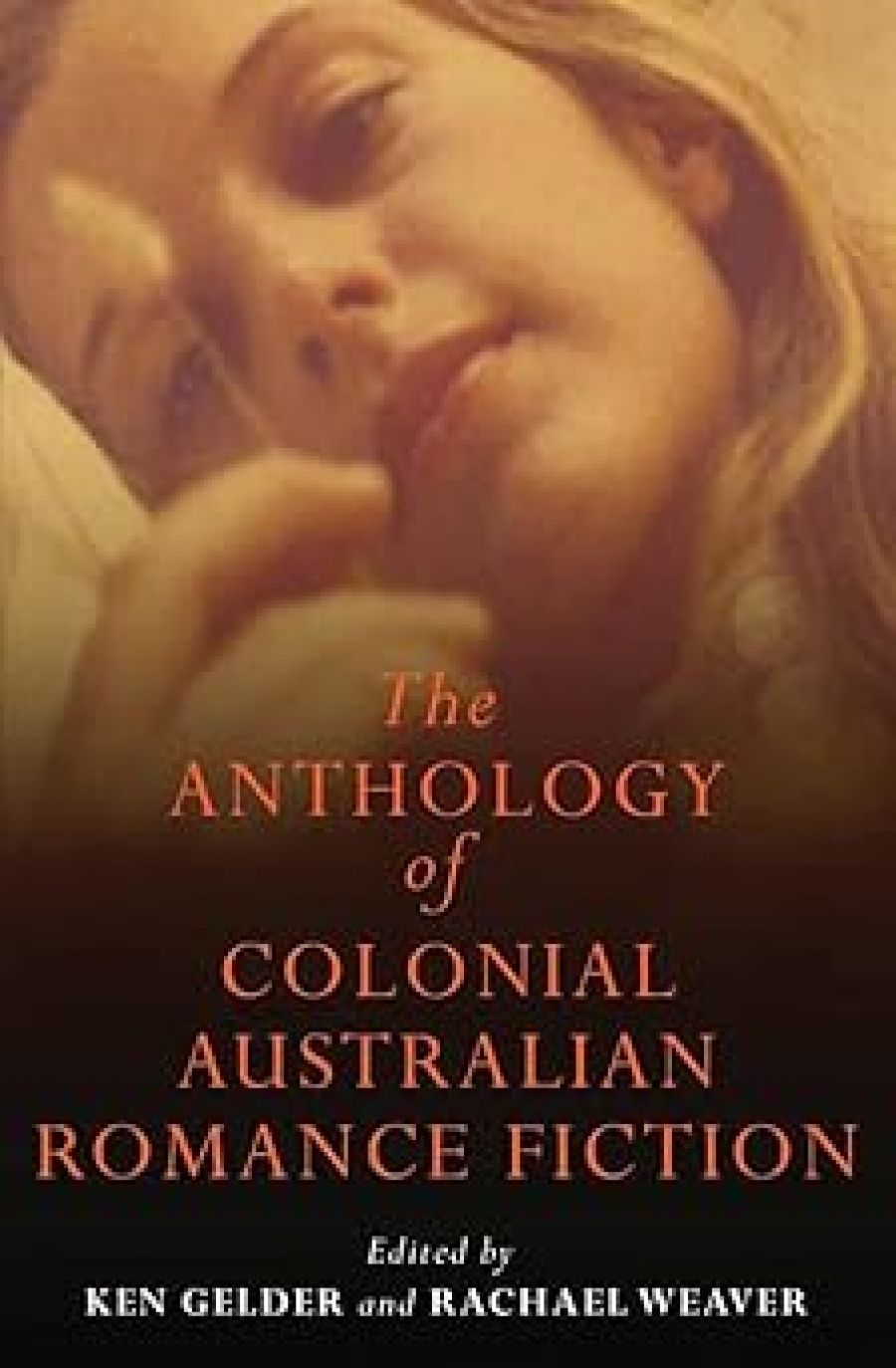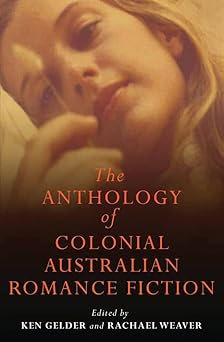
- Free Article: No
- Contents Category: Fiction
- Review Article: Yes
- Article Title: Fleeting colonial moments
- Online Only: No
- Custom Highlight Text:
The dreamy-eyed young girl from Peter Weir’s film Picnic at Hanging Rock, whose image adorns the cover of this anthology, gives a misleading impression of the ‘Australian girl’ who features in most of the stories. This girl may be the central figure in the colonial romance genre, as the editors propose, but she is characterised by energy and independence, rather than by the kind of sexually charged haze that surrounds the girls in the 1975 film. For the most part, her romantic experiences lead straight to marriage, give or take the odd misunderstanding along the way, and marriage was an institution entangled in economic security, social stability and, ultimately, the national destiny of white settler Australia. The Australian girl of the period was of necessity a clear-eyed realist where marriage was concerned. ‘Lorna Travis; A Christmas Story’ makes the economics of marriage very clear, while in Ada Cambridge’s ‘A Sweet Day’, an English aristocrat in disguise falls for a capable colonial girl and rewards her with a title as well as a wedding ring.
- Book 1 Title: The Anthology of Colonial Australian Romance Fiction
- Book 1 Biblio: Melbourne University Publishing, $34.99 pb, 278 pp
- Book 1 Cover Small (400 x 600):

If marriage is not the destination of romance, then disappointment in love is the outcome. Such stories may be touched with the pathos of missed opportunity, like ‘A Romance of Coma’, or laden with the melodrama of betrayal, like ‘The Desolate Homestead’. Rosa Praed’s ‘The Bushman’s Love Story’ has it both ways, transforming an old story of lost love into a dramatic happy ending as the narrator brings the lovers together again. Only two stories concern married women: one is the classically disappointed woman of the period, whose virtue is endangered by the possibility of extramarital romances (‘Cross Currents’); the other trans-forms her chilly marriage of convenience into a romance with the help of The Rubáiyát of Omar Khayyám (‘A Book of Verses’).
Variations on the theme of pride and prejudice can be found in ‘The Red Kangaroo’, where a proud beauty is brought to her knees by her admirer’s near-fatal mauling by a kangaroo, and ‘A Bush Girl’, where an arrogant New Chum gets his comeuppance from said girl: ‘“What do you take us for, us ko-lon-ial girls?” (The phrase sarcastically drawled out).’ Another New Chum succeeds with an Australian girl only after many dangers from murderous ‘blacks’ and insults from her (‘The Inside Station’). She is boyish and remote, whereas the enigmatic figure of the effeminate boy in ‘The Larrikin of Diamond Creek’ turns out to be a girl in disguise. The anthology features more bush settings than city drawing rooms, and a number of shipboard romances as well.
It was not only female authors who wrote colonial romance fiction. Male writers represented here include Henry Lawson, whose half-page sketch, ‘A Love Story’, tells it all, while his second contribution, ‘An Unfinished Love Story’, presents a man’s seduction of a girl as chilling cruelty rather than melodramatic villainy. An anti-romantic story from a sceptical female perspective is Mabel Forrest’s ‘The Housekeeper’.
There are constraints on the kinds of romance plots that can be developed within the short story, which is often, as the editors say, ‘a matter of fleeting moments and seemingly arbitrary choices’. The anthology implies that a selection of short fiction can represent colonial romance, but the novels of Ada Cambridge, Rosa Praed, ‘Tasma’ (Jessie Couvreur), Catherine Martin and others use the romance genre differently, to explore the meanings of marriage and settlement in colonial society. Curiously, the editors have nothing to say about recent literary historical work on ‘the Australian girl’ and colonial romance novels – to name only the two book-length studies: Fiona Giles’s Too Far Everywhere: Situating the Heroine in Nineteenth-century Australian Fiction (1998) and Tanya Dalziell’s Settler Romances and the Australian Girl (2004).
While the editors draw attention to the wealth of publication possibilities in colonial and English papers, both for short stories and for serialised novels, they do not look into the censorship likely to have operated when writing for family newspapers as distinct from separately published novels. They have, however, included a couple of faintly scandalous stories about women behaving badly – ‘Victims of Circe’, by Mrs Mannington Caffyn, and ‘Cross Currents’, by Mrs Patchett Martin – both of which first appeared in annual anthologies of Australian stories, bound for the English market. Could this form of publication have influenced their content? More scholarly apparatus, deftly presented, would have indicated places and dates of first publication – very useful in cases where the story is reprinted in an author’s collected stories, published some twenty years later.
The editors’ introduction does not mention that this anthology is one of several (the others are on colonial Gothic and colonial crime fiction) to come out of a major research project, Colonial Australian Popular Fiction. Yet the project’s website, http://www.apfa.esrc.unimelb.edu.au/home.html, is a rich resource that includes many scanned texts as well as a large bibliography of fiction, notes on hundreds of authors, and on genres and publishers. Many of the anthologised stories are already available online. ‘The Red Kangaroo’, for example, is accessible from Sydney University’s SETIS collection and from the AustLit Resource Database. While it seems a pity that precious research resources are used in duplicating material, easy access to such colonial texts, whether in print or online, is very welcome, and offers fascinating insights into colonial perceptions and sensibilities.


Comments powered by CComment